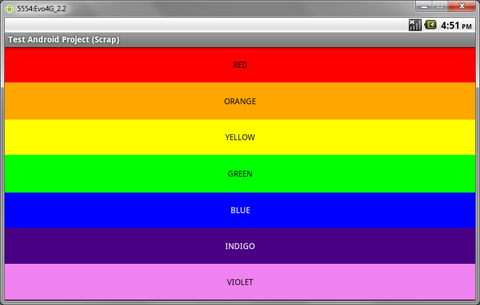編輯:高級開發
我們報道過android單線程模型相關概念詳解,在開發android應用時必須遵守單線程模型的原則:android UI操作並不是線程安全的並且這些操作必須在UI線程中執行。
在單線程模型中始終要記住兩條法則:
當一個程序第一次啟動時,android會同時啟動一個對應的主線程(Main Thread),主線程主要負責處理與UI相關的事件,如:用戶的按鍵事件,用戶接觸屏幕的事件以及屏幕繪圖事件,並把相關的事件分發到對應的組件進行處理。所以主線程通常又被叫做UI線程。
比如說從網上獲取一個網頁,在一個TextVIEw中將其源代碼顯示出來,這種涉及到網絡操作的程序一般都是需要開一個線程完成網絡訪問,但是在獲得頁面源碼後,是不能直接在網絡操作線程中調用TextVIEw.setText()的.因為其他線程中是不能直接訪問主UI線程成員
android提供了幾種在其他線程中訪問UI線程的方法。
- Activity.runOnUiThread( Runnable )
- VIEw.post( Runnable )
- VIEw.postDelayed( Runnable, long )
- Hanlder
這些類或方法同樣會使你的代碼很復雜很難理解。然而當你需要實現一些很復雜的操作並需要頻繁地更新UI時這會變得更糟糕。
為了解決這個問題,android 1.5提供了一個工具類:AsyncTask,它使創建需要與用戶界面交互的長時間運行的任務變得更簡單。不需要借助線程和Handler即可實現。
AsyncTask是抽象類.AsyncTask定義了三種泛型類型 Params,Progress和Result。
◆Params 啟動任務執行的輸入參數,比如HTTP請求的URL。
◆Progress 後台任務執行的百分比。
◆Result 後台執行任務最終返回的結果,比如String。
AsyncTask的執行分為四個步驟,每一步都對應一個回調方法,這些方法不應該由應用程序調用,開發者需要做的就是實現這些方法。
onPreExecute(), 該方法將在執行實際的後台操作前被UI thread調用。可以在該方法中做一些准備工作,如在界面上顯示一個進度條。
doInBackground(Params...), 將在onPreExecute 方法執行後馬上執行,該方法運行在後台線程中。這裡將主要負責執行那些很耗時的後台計算工作。可以調用 publishProgress方法來更新實時的任務進度。該方法是抽象方法,子類必須實現。
onProgressUpdate(Progress...),在publishProgress方法被調用後,UI thread將調用這個方法從而在界面上展示任務的進展情況,例如通過一個進度條進行展示。
onPostExecute(Result), 在doInBackground 執行完成後,onPostExecute 方法將被UI thread調用,後台的計算結果將通過該方法傳遞到UI thread.
為了正確的使用AsyncTask類,以下是幾條必須遵守的准則:
1) Task的實例必須在UI thread中創建
2) execute方法必須在UI thread中調用
3) 不要手動的調用onPreExecute(), onPostExecute(Result),doInBackground(Params...), onProgressUpdate(Progress...)這幾個方法
4) 該task只能被執行一次,否則多次調用時將會出現異常
從網上獲取一個網頁,在一個TextVIEw中將其源代碼顯示出來
- package test.list;
- import Java.io.ByteArrayOutputStream;
- import Java.io.InputStream;
- import Java.util.ArrayList;
- import org.apache.http.HttpEntity;
- import org.apache.http.HttpResponse;
- import org.apache.http.client.HttpClIEnt;
- import org.apache.http.clIEnt.methods.HttpGet;
- import org.apache.http.impl.client.DefaultHttpClIEnt;
- import android.app.Activity;
- import android.app.ProgressDialog;
- import android.content.Context;
- import android.content.DialogInterface;
- import android.os.AsyncTask;
- import android.os.Bundle;
- import android.os.Handler;
- import android.os.Message;
- import android.view.VIEw;
- import android.widget.Button;
- import android.widget.EditText;
- import android.widget.TextVIEw;
- public class NetworkActivity extends Activity{
- private TextVIEw message;
- private Button open;
- private EditText url;
- @Override
- public void onCreate(Bundle savedInstanceState) {
- super.onCreate(savedInstanceState);
- setContentVIEw(R.layout.Network);
- message= (TextView) findVIEwById(R.id.message);
- url= (EditText) findVIEwById(R.id.url);
- open= (Button) findVIEwById(R.id.open);
- open.setOnClickListener(new VIEw.OnClickListener() {
- public void onClick(VIEw arg0) {
- connect();
- }
- });
- }
- private void connect() {
- PageTask task = new PageTask(this);
- task.execute(url.getText().toString());
- }
- class PageTask extends AsyncTask<String, Integer, String> {
- // 可變長的輸入參數,與AsyncTask.exucute()對應
- ProgressDialog pdialog;
- public PageTask(Context context){
- pdialog = new ProgressDialog(context, 0);
- pdialog.setButton("cancel", new DialogInterface.OnClickListener() {
- public void onClick(DialogInterface dialog, int i) {
- dialog.cancel();
- }
- });
- pdialog.setOnCancelListener(new DialogInterface.OnCancelListener() {
- public void onCancel(DialogInterface dialog) {
- finish();
- }
- });
- pdialog.setCancelable(true);
- pdialog.setMax(100);
- pdialog.setProgressStyle(ProgressDialog.STYLE_HORIZONTAL);
- pdialog.show();
- }
- @Override
- protected String doInBackground(String... params) {
- try{
- HttpClIEnt clIEnt = new DefaultHttpClIEnt();
- // params[0]代表連接的url
- HttpGet get = new HttpGet(params[0]);
- HttpResponse response = clIEnt.execute(get);
- HttpEntity entity = response.getEntity();
- long length = entity.getContentLength();
- InputStream is = entity.getContent();
- String s = null;
- if(is != null) {
- ByteArrayOutputStream baos = new ByteArrayOutputStream();
- byte[] buf = new byte[128];
- int ch = -1;
- int count = 0;
- while((ch = is.read(buf)) != -1) {
- baos.write(buf, 0, ch);
- count += ch;
- if(length > 0) {
- // 如果知道響應的長度,調用publishProgress()更新進度
- publishProgress((int) ((count / (float) length) * 100));
- }
- // 讓線程休眠100ms
- Thread.sleep(100);
- }
- s = new String(baos.toByteArray()); }
- // 返回結果
- return s;
- } catch(Exception e) {
- e.printStackTrace();
- }
- return null;
- }
- @Override
- protected void onCancelled() {
- super.onCancelled();
- }
- @Override
- protected void onPostExecute(String result) {
- // 返回Html頁面的內容
- message.setText(result);
- pdialog.dismiss();
- }
- @Override
- protected void onPreExecute() {
- // 任務啟動,可以在這裡顯示一個對話框,這裡簡單處理
- message.setText(R.string.task_started);
- }
- @Override
- protected void onProgressUpdate(Integer... values) {
- // 更新進度
- System.out.println(""+values[0]);
- message.setText(""+values[0]);
- pdialog.setProgress(values[0]);
- }
- }
- }
 Android用戶界面設計:線性布局(1)
Android用戶界面設計:線性布局(1)
理解布局對於良好的android程序設計來說很重要。在這個教程中,你將學習到所有關於線性布局的東西,它在屏幕上垂直地或水平地組織用戶界面控件或者小工具。使用得當,線性布
 在Android平台下開發多媒體軟件MediaPlayer
在Android平台下開發多媒體軟件MediaPlayer
在前文中我們介紹了在Ubuntu下建立Eclipse的android開發環境,我們現在將介紹一下在android平台下如何開發多媒體軟件MediaPlayer。Medi
 新穎的Android手機全解析
新穎的Android手機全解析
一些對android手機癡迷的用戶來說,Android手機的推出,已經彌補了他們心中的那塊心病,Android手機的問世,對於整個手機市場來說這是一個很大的競爭對手,導
 圖解Dalvik虛擬機相關配置
圖解Dalvik虛擬機相關配置
Google於2007年底正式發布了android SDK, 作為 android系統的重要特性,Dalvik虛擬機也第一次進入了人們的視野。它對內存的高效使用,和在低